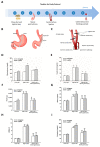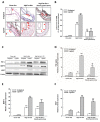Vertical Sleeve Gastrectomy Offers Protection against Disturbed Flow-Induced Atherosclerosis in High-Fat Diet-Fed Mice
- PMID: 36982743
- PMCID: PMC10051344
- DOI: 10.3390/ijms24065669
Vertical Sleeve Gastrectomy Offers Protection against Disturbed Flow-Induced Atherosclerosis in High-Fat Diet-Fed Mice
Abstract
Bariatric surgery reduces body weight, enhances metabolic and diabetic control, and improves outcomes on obesity-related comorbidities. However, the mechanisms mediating this protection against cardiovascular diseases remain unclear. We investigated the effect of sleeve gastrectomy (SG) on vascular protection in response to shear stress-induced atherosclerosis using an overweighted and carotid artery ligation mouse model. Eight-week-old male wild-type mice (C57BL/6J) were fed a high-fat diet (HFD) for two weeks to induce weight gain and dysmetabolism. SG was performed in HFD-fed mice. Two weeks after the SG procedure, partial carotid-artery ligation was performed to promote disturbed flow-induced atherosclerosis. Compared with the control mice, HFD-fed wild-type mice exhibited increased body weight, total cholesterol level, hemoglobin A1c, and enhanced insulin resistance; SG significantly reversed these adverse effects. As expected, HFD-fed mice exhibited greater neointimal hyperplasia and atherosclerotic plaques than the control group, and the SG procedure attenuated HFD-promoted ligation-induced neointimal hyperplasia and arterial elastin fragmentation. Besides, HFD promoted ligation-induced macrophage infiltration, matrix metalloproteinase-9 expression, upregulation of inflammatory cytokines, and increased vascular endothelial growth factor secretion. SG significantly reduced the above-mentioned effects. Moreover, HFD restriction partially reversed the intimal hyperplasia caused by carotid artery ligation; however, this protective effect was significantly lower than that observed in SG-operated mice. Our study demonstrated that HFD deteriorates shear stress-induced atherosclerosis and SG mitigates vascular remodeling, and this protective effect was not comparable in HFD restriction group. These findings provide a rationale for using bariatric surgery to counter atherosclerosis in morbid obesity.
Keywords: atherosclerosis; bariatric surgery; carotid artery ligation; insulin resistance; obesity; type 2 diabetes; vertical sleeve gastrectomy.
Conflict of interest statement
The authors declare no conflict of interest.
Figures




Similar articles
-
Effects of omentectomy in addition to sleeve gastrectomy on the metabolic and inflammatory profiles of obese rats.Surg Obes Relat Dis. 2016 Aug;12(7):1292-1299. doi: 10.1016/j.soard.2016.01.026. Epub 2016 Feb 1. Surg Obes Relat Dis. 2016. PMID: 27039133
-
Sleeve gastrectomy induces weight loss in diet-induced obese rats even if high-fat feeding is continued.Obes Surg. 2011 Sep;21(9):1438-43. doi: 10.1007/s11695-010-0277-x. Obes Surg. 2011. PMID: 20835897
-
Effects of Left Gastric Artery Ligation Versus Sleeve Gastrectomy on Obesity-Induced Adipose Tissue Macrophage Infiltration and Inflammation in Diet-Induced Obese Rats.Med Sci Monit. 2019 Sep 7;25:6719-6726. doi: 10.12659/MSM.915532. Med Sci Monit. 2019. PMID: 31493329 Free PMC article.
-
Intimal hyperplasia in murine models.Curr Drug Targets. 2008 Mar;9(3):251-60. doi: 10.2174/138945008783755601. Curr Drug Targets. 2008. PMID: 18336244 Free PMC article. Review.
-
Stress granules in atherosclerosis: Insights and therapeutic opportunities.Curr Probl Cardiol. 2024 Oct;49(10):102760. doi: 10.1016/j.cpcardiol.2024.102760. Epub 2024 Jul 24. Curr Probl Cardiol. 2024. PMID: 39059785 Review.
References
MeSH terms
Substances
LinkOut - more resources
Full Text Sources
Medical
Research Materials

